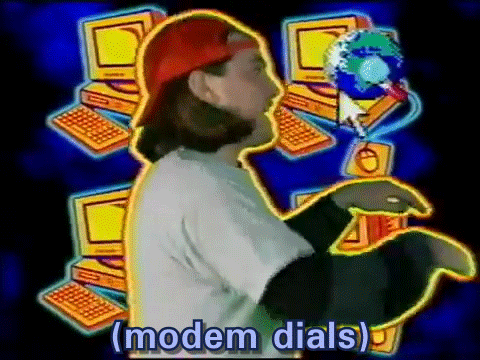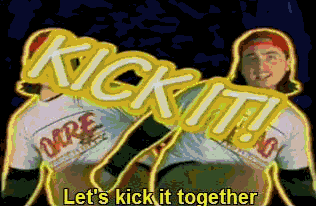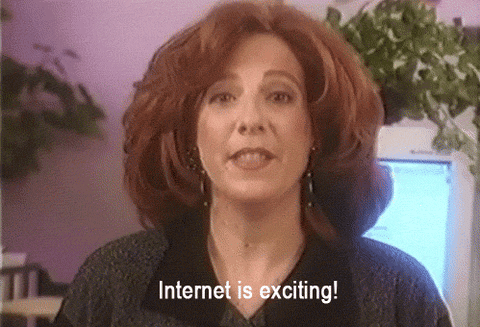"Another one?!" I hear you say. "I can barely keep up with the one we've got. I haven't even got a Twitter account yet!" Wowee. Wait until you hear about the Metaverse.

So, what is it? Where is it? Who is it? How is it? Let's find out.
Well, before we get into why Web 3.0 applies to marketing, we have to figure out what it is.
What is Web 3.0?
Web 3.0 is the future of the internet. It involves a space where people operate on decentralised, almost anonymous platforms. This means moving away from the big, guiding hands of tech giants like Google, Facebook, and Twitter.
Web 3.0 was originally called the Semantic Web by World Wide Web inventor Tim Berners-Lee, and was conceived as a more autonomous, intelligent, and open internet.
Good ol' Tim coined the term to describe a web where AI and machines would process content like a "global brain", i.e. all data, connected in a way that is both contextual and conceptual.
This Semantic Web didn't pan out exactly, mostly because the AI technology needed was nearly impossible to implement. But what appeared was more similar to B-L's original web, where “no permission is needed from a central authority to post anything … there is no central controlling node, and so no single point of failure … and no “kill switch”.
So, the decentralised technologies that have exploded in the last few years - De-Fi, Blockchain, AR Cloud, Distributed ledgers, AI and ML, The Metaverse - will mean a move towards data decentralisation and a transparent, secure internet. Something that seems almost alien compared to Web 2.0's centralisation, data surveillance, and all-too-accurate prevalent advertising.
As a result, Web 3.0 is growing from the ashes of old-generation web tools, combined with cutting-edge tech mentioned above and insane levels of connectivity between users and platforms. But to understand the future, we've got to understand the past, right? So, let's define:
Web 1.0 (1989-2005). This iteration of the web, also known as the Static Web, was the first internet in the 1990s. It offered access to limited info, with basically no user interactions.
Web 2.0 (2005-now-ish). This is known as the "social web", and relies on interactivity brought on by advancements in web technologies like JavaScript, HTML5, CSS3. This enabled Start ups to build interactive web platforms like Facebook and Wikipedia. This meant social networks and user-generated content productions could grow, using data shared between platforms and apps.
…and out of this evolution comes the next step: Web 3.0.
Why has Web 3.0 appeared?
So, this has all been accelerated, in part, by the shortcomings of the previous webs. The accumulation of control and power within centralised companies had far reaching, and enduring, impacts. From banks, to social platforms, even to companies taking ownership and monetising creators' works, trust was lost.
All this acted as a catalyst for the desire for decentralisation, and the growth of tech like blockchain and AI made this possible.
“The Global Financial Crisis of 2007-2008 had far-reaching impacts. It catalysed an implosion of trust in a number of institutions: the commercial banks whose business practices caused the crisis; the central banks that never saw it coming; and the governments that failed to address it effectively or hold the most irresponsible and negligent individuals to account,” MakerDAO, creator of the popular stablecoin DAI, wrote in April 2020.
“The drawbacks of centralised power became more evident, as did the power of technology.”
What does Web 3.0 mean for marketing?
This is what you're here for, right?
So, if you caught #MarTechFest Dial Up, you'd know this topic was one of Steven Bartlett’s big predictions for B2B this year.
Web 3.0 really offers many opportunities in marketing, one being it allows creators to own the things they create, and people to own the financial upside for the things they consume.
“Web3 is where everything becomes decentralised. We don’t need to rely on Amazon. We don’t need to rely on banks”
But Steven’s big prediction is around blockchain and NFTs.
But why does he think web 3.0, blockchain, and NFTs are so interesting?
“We’re seeing this tremendous desire, and opportunity, to shift to a more decentralised world for brands and creatives.”
So, this decentralisation isn’t just a case of cutting out harmful algorithms or middlemen, but can offer an entirely new economy for creatives.
There's an opportunity to bypass the traditional ways creators and influencers have made money in the past i.e., brands, agencies, and advertisers.

The reason digital creators haven't been in full control of their careers in the past is due to this; creators have often had to represent brands, or act in certain ways, to maintain their income.
Content creators may have millions of followers, and plenty of influence, but they'd still have to bend to the companies that fund them. This means they're not fully in control of their own image, brand, or personality.
Steven sees this as a massive shift and gives the example of Soho House, a private members' club with exclusive access, which could, in theory offer private memberships as NFTs, by using Web 3.0 technology:
What if there were only 100,000 Soho House memberships in the world as NFTs and the only way you could get one was going online and buying one from an existing member? I'd say what would happen would be an authentic scarcity, with a finite number of memberships which would drive the price up every single time one is sold or moved.
Soho House would take a cut (from each sale) and, for me, that's going to be the future of ticketing, memberships, audiences, events, art and music."
How will this aid the creator economy?
“Web3 is the internet owned by the builders and users, orchestrated with tokens," says Packy McCormick. This offers a real shift in what is known as the 'creator economy'. Everything becomes about decentralisation, and putting the financial benefit of creativity back into the hands of creatives.
You can now own the thing you create…I can now tokenise my community.
That means if you’re a ticketing company, if you’re a fashion brand, if you're an entrepreneur, if you’re a creator, you can now own the things you create”.
-Steven Bartlett
The creator economy has enabled individuals to create digital content that utilises blockchain technology. This could, number one, alter what the financial landscape looks like for these creators, and number two, make it possible to earn a lot of money on a single piece of work alone.
Peter Yang believes that, with NFTs, creators won’t have to deal with intermediaries who can take control of content rights, as well as their visibility and a percentage of earnings.
Platforms like BitClout have sprung up out of all this excitement. Over one seven days period the site saw 4,000 NFTs created, with 7,000 bids made, and 2,000 sold. BitClout self-describes as "decentralising social media."
But what does Steven think?
“So, for me, instead of having followers, who are just numbers on my Instagram, I can now tokenise my community”
So, he can develop a Steven Bartlett token or card, drop it for free, and everyone who gets one gets special access to him and his content. From special messages, to royalties on the money he makes, his followers can benefit from supporting him directly, in the specific way they’d like.
“It’s like you betting on that future”
It’s about owning the things you consume, and benefiting financially from the things you consume. And Steven thinks this’ll cause a massive shift.
He’s talking to the most forward thinking brands about NFTs, and is planning NFT drops for them.
”Don’t think about it like art. Think about it like removing the middle man”
Let's have a look into some key features of Web 3.0 marketing, shall we?
What tech will define Web 3.0 marketing?
AI. Artificial intelligence is a big Web 3.0 star. With the Natural Language Processing tech, computers will be able to understand and interpret contextualised data, and provide accurate responses.
Internet of Things. The number of devices connected to the internet increases every day. This enables the web to be constantly present and available to every person. According to Marketo, it will help marketers in:
- Analysing customer buying habits across platforms;
- Gathering previously unobtainable data about how consumers interact with devices and products;
- Gaining deeper insights where a customer is in the buying journey
Blockchain. Blockchain tech is all about getting rid of centralised systems, and creating an open ecosystem that can reinvent the digital marketing industry. Plus, it can aid in data security and data centralisation. Web 3.0 basically means companies becoming highly user-centric and transparent, with users having direct control over their data and privacy. All of this leads to consumer trust.

